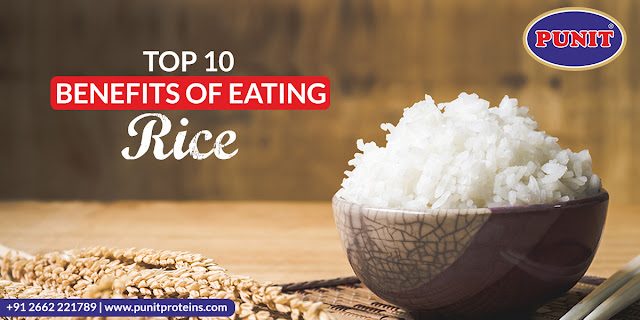Characteristics of different types of Rice
Unlike potatoes and pasta, rice may be prepared in a wide variety of ways, and it tastes great. Take a look at this breakdown of the many options.
Different types of rice, categorised by the length of their grains, can have a variety of mouthfeels, from light and airy to rich and sticky. Shades of brown, white, and red are all present.
Different types of rice require different preparation methods and are better suited to different cuisines due to their unique size, shape, and texture. In terms of food, different nations have distinct preferences. If you are looking for the most prominent supplier of Non-sticky basmati rice in India, Punit Proteins is the best choice for you.
Different Types of Rice:
-
Long-grain rice:
In keeping with its moniker,
long-grain rice features grains that are noticeably longer and narrower than
standard short-grain varieties. The grains normally stay separate during
cooking, and the final product is usually dry and solid. Even though long-grain
brown rice is also available, the vast majority of rice sold is in its refined
white form. Patna rice originates in Asia, while the slightly chunkier Carolina
rice is a product of the United States of America.
-
Basmati rice:
Basmati rice is long-grain rice
characterised by very long, slender grains that retain their shape and flavour
when cooking. Besides its native range in northern states of India as well as
Pakistan, no other rice may legitimately be called basmati. Wholegrain
varieties of this rice are typically more delicate and speedier to prepare than
their brown rice counterparts. Basmati rice has a lower Glycaemic Index than
other forms of rice, meaning that all of the carbohydrate content present
inside gets absorbed slowly into the bloodstream. This aids in maintaining
steady blood glucose levels. The starchy milling powder can be removed by
rinsing Basmati rice before cooking.
-
Chinese black rice:
Rice that has not been processed has
a darker outer layer and wider, flatter grains. Typically, it is soaked and
steamed. Palm sugar along with Coconut milk, are combined to make a sweet treat
in Asia.
-
Glutinous rice:
Sticky rice, often known as Chinese
rice, is a staple ingredient in many Southeast Asian recipes. It has very
round, white, chalky grains. The name is ironic given that it is gluten-free
like any other type of rice. After being soaked and steamed, the grains become
incredibly sticky and almost impossible to separate. You can roll it into
little balls and eat it with your fingers or chopsticks. Leaving the sticky
rice aside, choose Non-sticky basmati rice by Punit Proteins.
-
Jasmine rice:
The eastern Asian region is
responsible for the cultivation of aromatic rice such as Thai fragrant rice.
Perfumed and somewhat stickier as compared to the other long-grain rice after
cooking, this kind is unique. Thai cooking typically employs this rice because of
its versatility and ability to complement other Asian flavours.
-
Paella rice:
Produced in the Valencia region, this
is a staple ingredient in the national meal of Spain, paella. It resembles
risotto rice in that it has a plump, short grain, but the texture is less
creamy.
-
Par-boiled rice:
This is wholegrain rice that has been
soaked, steamed, and dried before being milled and polished; it is sometimes
referred to as processed or converted rice. More nutrients are maintained
thanks to the technique, which concentrates them in the centre where they would
normally be lost in regular white rice. This rice has a more golden hue than
regular white rice and requires a slightly longer cooking time. The grains
won't clump together even if you overcook them.
-
Quick-cook rice:
This is not the same as parboiled
rice despite going by the same name. Unlike regular long-grain rice, quick-cook
rice only needs roughly half the time to cook since it is partially boiled
after milling and is then left to dry. Since it is cooked twice as long as
regular rice, this rice loses a lot of its nutritional value, notably the B
vitamins that are water-soluble.
-
Red rice:
Red whole-grain rice possesses a
nutty flavour along with a little chewy texture. Camargue, France produces the highest
grade red rice, however, red rice grown in North America is also available.
-
Risotto rice:
Italy is known for its medium-grain
rice, which has round, plump grains and white colour. Grain texture and
individual shape are preserved while cooking with liquid mixed in slowly.
Vialone as well as Carnaroli Nano risotto rice are even superior to the more
popular Arborio. Punit Proteins is one of the excellent as well as most
distinct suppliers of Non-sticky basmati
rice in India.
-
Short and medium grain rice:
As a result of the presence of
amylopectin, a starchy component of rice, this rice tends to stick together.
The individual grains hold together after cooking, making this type of rice
ideal for risotto, pudding, and sushi, among other foods.
-
Sushi rice:
Short-grain rice, such as that used
in sushi, is often soaked and cooked using the absorption method. To make
sushi, materials like raw fish or vegetables are chilled and seasoned before
being rolled up in nori seaweed. Sushi rolls stay together because of the
sticky rice.



Comments
Post a Comment